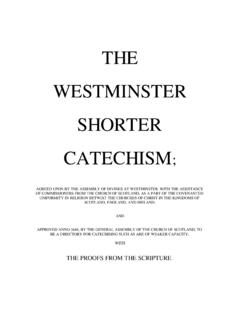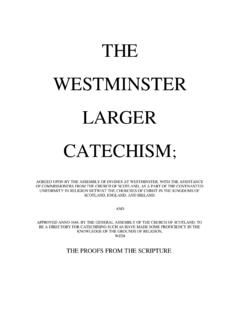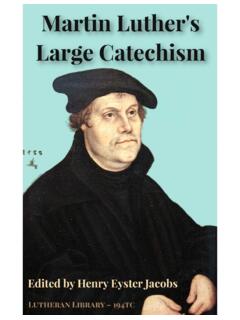Transcription of The Heidelberg Catechism
1 The Heidelberg Catechism or METHOD OF INSTRUCTION IN THE CHRISTIAN RELIGION AS THE SAME IS TAUGHT IN THE REFORMED CHURCHES AND SCHOOLS IN HOLLAND AND IN AMERICA The Heidelberg Catechism received its name from being composed in Heidelberg at the request of Elector Frederick III (1516 1576), ruler of the Palatinate, an influential German province. To secure harmony in Protestant teaching and to facilitate the establishment of the Reformed faith in his province, this pious prince commissioned Zacharias Ursinus (1534 1583), twenty-eight years of age and professor of theology at the Heidelberg University, and Caspar Olevianus (1536 1587), twenty-six years old and Frederick s court preacher, to prepare a Reformed Catechism for instructing the youth and guiding pastors and teachers.
2 Of these two young and learned divines, Ursinus bore the primary responsibility for the Catechism s material content, while Olevianus was more involved in final composition and editing. Blessed by the Spirit, the learning of Ursinus and the eloquence of Olevianus are reflected in the final product a Catechism of unusual power and beauty, an acknowledged masterpiece. Further, Frederick indicates that many others, including the theological faculty and the chief officers of the Palatinate church, provided assistance in perfecting its final reading. After the Catechism was approved by a Heidelberg Synod in January 1563, three additional German editions, each with small additions, as well as a Latin translation, were published the same year in Heidelberg .
3 The fourth edition is regarded as the official text of the Catechism and is used as a basis for the English translation printed on the following pages. When the first edition of the Heidelberg Catechism appeared, the German Bible had not yet been divided into verses. Consequently, Scripture passages listed in the margin included only book and chapter. Moreover, the Catechism s questions were not numbered. A Latin translation soon rectified these problems by including verse references and numbering the questions. Moreover, the Catechism was also soon divided into fifty-two sections so that one section referred to as Lord s Day could be expounded each Sunday of the year. In this present edition the more than 700 textual references have been printed in full for good reason.
4 The Catechism contains more prooftexts than other catechisms of its day because its authors wanted it to be an echo of the Bible. These prooftexts were to be regarded as an important part of the Catechism , as noted in Frederick s original preface: The Scripture proof by which the faith of the children is confirmed are such only as have been selected with great pains from the divinely inspired Scriptures. The Heidelberg Catechism s 129 questions and answers are divided into three parts patterned after the book of Romans. After a moving introduction related to the true believer s comfort, questions 3 11 consider the experience of sin and misery (Romans 1 3:20); questions 12 85 are concerned with redemption in Christ and faith (Romans 3:21 11:36), incorporating a lengthy exposition of the Apostles Creed and the sacraments; questions 86 129 stress true gratitude for God s deliverance (Romans 12 16), primarily through a consideration of the Ten commandments and the Lord s Prayer.
5 One of the Catechism s precious distinctives is its presentation of doctrines with clarity and warm piety in an experiential, practical manner. It is more subjective than objective, more spiritual than dogmatical. It is not surprising that the Catechism , so personal and devotional throughout as exemplified in its use of singular pronouns, has been called the book of comfort for God s people. The Catechism was translated already in 1563 into Dutch by Petrus Dathenus and was published in his rhymed Psalter in 1566. Its personal style and experiential content soon won the love of God s people also in the Netherlands. Already that same year Peter Gabriel set a pattern for Dutch ministers by expounding the Catechism every Sunday afternoon to his Amsterdam congregation.
6 Moreover, the Catechism was approved by the Synods of Wesel (1568), Embden (1571), Dort (1578), the Hague (1586), as well as the great Synod of Dort (1618 1619), which officially adopted it as the second of the Three Forms of Unity and made its weekly exposition by the ministers obligatory. The Heidelberg Catechism has been translated into all European and dozens of Asiatic and African languages. It is thought to have been circulated more widely than any other book except the Bible, The Imitation of Christ, and Pilgrim s Progress. Diffused with the unction of the Spirit, soundly Calvinistic, yet moderate in tone and irenic in spirit, this precious book of comfort remains the most widely used and warmly praised Catechism of the Reformation period. LORD S DAY 1 Question 1: What is thy only comfort in life and death?
7 Answer: That I with body and soul, both in life and death,1 am not my own,2 but belong unto my faithful Savior Jesus Christ;3 who, with His precious blood,4 hath fully satisfied for all my sins,5 and delivered me from all the power of the devil;6 and so preserves me7 that without the will of my heavenly Father, not a hair can fall from my head;8 yea, that all things must be subservient to my salvation,9 and therefore, by His Holy Spirit, He also assures me of eternal life,10 and makes me sincerely willing and ready, henceforth, to live unto Question 2: How many things are necessary for thee to know, that thou, enjoying this comfort, mayest live and die happily? Answer: Three;12 the first, how great my sins and miseries are;13 the second, how I may be delivered from all my sins and miseries;14 the third, how I shall express my gratitude to God for such _____ 11 Cor.
8 6:19 20, What? know ye not that your body is the temple of the Holy Ghost which is in you, which ye have of God, and ye are not your own? For ye are bought with a price: therefore glorify God in your body, and in your spirit, which are God s. 2 Rom. 14:7 9, For none of us liveth to himself, and no man dieth to himself. For whether we live, we live unto the Lord; and whether we die, we die unto the Lord: whether we live therefore, or die, we are the Lord s. For to this end Christ both died, and rose, and revived, that He might be Lord both of the dead and living. 31 Cor. 3:23, And ye are Christ s; and Christ is God s. 41 Pet. 1:18 19, Forasmuch as ye know that ye were not redeemed with corruptible things, as silver and gold, from your vain conversation received by tradition from your fathers; but with the precious blood of Christ, as of a lamb without blemish and without spot.
9 5 John 1:7, The same came for a witness, to bear witness of the Light, that all men through Him might believe. 61 John 3:8, He that committeth sin is of the devil; for the devil sinneth from the beginning. For this purpose the Son of God was manifested, that He might destroy the works of the devil. Heb. 2:14 15, Forasmuch then as the children are partakers of flesh and blood, He also Himself likewise took part of the same; that through death He might destroy him that had the power of death, that is, the devil; and deliver them who through fear of death were all their lifetime subject to bondage. 7 John 6:39, And this is the Father s will which hath sent Me, that of all which He hath given Me I should lose nothing, but should raise it up again at the last day. John 10:28 29, And I give unto them eternal life; and they shall never perish, neither shall any man pluck them out of My hand.
10 My Father, which gave them Me, is greater than all; and no man is able to pluck them out of My Father s hand. 8 Luke 21:18, But there shall not an hair of your head perish. Matt. 10:30, But the very hairs of your head are all numbered. 9 Rom. 8:28, And we know that all things work together for good to them that love God, to them who are the called according to His purpose. 102 Cor. 1:22, Who hath also sealed us, and given the earnest of the Spirit in our hearts. 2 Cor. 5:5, Now He that hath wrought us for the selfsame thing is God, who also hath given unto us the earnest of the Spirit. 11 Rom. 8:14, For as many as are led by the Spirit of God, they are the sons of God. Rom. 7:22, For I delight in the law of God after the inward man. 12 Luke 24:47, And that repentance and remission of sins should be preached in His Name among all nations, beginning at Jerusalem.




